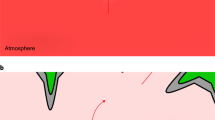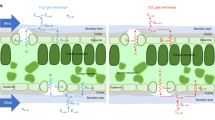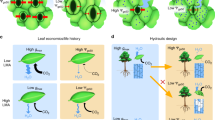Abstract
DURING the past ten years major advances have been made in our understanding of the mechanics of stomata. A most important discovery has been that potassium enters the guard cells in sufficient quantities to account for the decreases in osmotic potential which occur on stomatal opening1. Association of potassium with stomatal movements has now been reported for at least 22 species2. There is doubt, however, about the nature of the anions which accompany K+. Chloride has been found to balance about 40% of the K+ in Zea mays3 and considerably less in Commelina communis4. Malate could be the balancing anion as it has been found to accumulate in the guard cells on stomatal opening5 although it is not clear whether it is synthesised in the guard cells or is transported there from the surrounding cells. Clearly an understanding of the mechanism of the ion transport in and out of the guard cells is necessary as a first step to the unravelling of the stomatal mechanism. An hypothesis is proposed here which attempts to explain the transport aspect of stomatal function. It is based mainly on data obtained from studies with the monocotyledon C. communis but should be applicable to other species.
This is a preview of subscription content, access via your institution
Access options
Subscribe to this journal
Receive 51 print issues and online access
$199.00 per year
only $3.90 per issue
Buy this article
- Purchase on Springer Link
- Instant access to full article PDF
Prices may be subject to local taxes which are calculated during checkout
Similar content being viewed by others
References
Meidner, H., and Willmer, C., Curr. Adv. Pl. Sci., 17, 1–15 (1975).
Dayanandan, P., and Kaufman, P. B., Am. J. Bot., 62, 221–231 (1975).
Raschke, K., and Fellows, M. P., Planta, 101, 296–316 (1971).
Penny, M. G., Kelday, L. S., and Bowling, D. J. F., Planta (in the press).
Allaway, W. G., Planta, 110, 63–70 (1973).
Penny, M. G., and Bowling, D. J. F., Planta, 119, 17–25 (1974).
Penny, M. G., and Bowling, D. J. F., Planta, 122, 209–212 (1975).
Cram, W. J., J. exp. Bot., 25, 253–268 (1974).
Humble, G. D., and Hsiao, T. C., Pl. Physiol., Lancaster, 44, 230–234 (1969).
Willmer, C. M., and Mansfield, T. A., New Phytol., 68, 363–375 (1969).
Author information
Authors and Affiliations
Rights and permissions
About this article
Cite this article
BOWLING, D. Malate-switch hypothesis to explain the action of stomata. Nature 262, 393–394 (1976). https://doi.org/10.1038/262393a0
Received:
Accepted:
Published:
Issue Date:
DOI: https://doi.org/10.1038/262393a0
This article is cited by
-
The Sustainable Reasons of Controversy over the Mechanisms for the Stomatal Opening
Journal of Plant Biology (2019)
-
Potassium content and aperture in “intact” stomatal and epidermal cells ofCommelina communis L
The Journal of Membrane Biology (1980)
-
Stomata and plasmodesmata
Protoplasma (1979)
-
Electrochemical investigation of active malic acid transport at the tonoplast into the vacuoles of the CAM plantKalanchoë daigremontiana
The Journal of Membrane Biology (1979)
-
Mechanism of stomatal movement
Nature (1977)
Comments
By submitting a comment you agree to abide by our Terms and Community Guidelines. If you find something abusive or that does not comply with our terms or guidelines please flag it as inappropriate.



